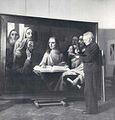Template:Selected anniversaries/November 12: Difference between revisions
No edit summary |
No edit summary |
||
| Line 6: | Line 6: | ||
||1746: Jacques Alexandre César Charles born ... inventor, scientist, mathematician, and balloonist. Pic. | ||1746: Jacques Alexandre César Charles born ... inventor, scientist, mathematician, and balloonist. Pic. | ||
||1793: Jean Sylvain Bailly | File:Jean_Sylvain_Bailly.jpg|link=Jean Sylvain Bailly (nonfiction)|1793: Astronomer, mathematician, and political leader [[Jean Sylvain Bailly (nonfiction)|Jean Sylvain Bailly]] is guillotined during the Reign of Terror. He participated in early stages of the French Revolution, presiding over the Tennis Court Oath, and serving as the mayor of Paris from 1789 to 1791. | ||
||1793: Johann Friedrich von Eschscholtz born ... physician and botanist ... traveller | ||1793: Johann Friedrich von Eschscholtz born ... physician and botanist ... traveller. | ||
||1833: Alexander Porfiryevich Borodin born ... composer of Georgian-Russian origin, as well as a doctor and chemist. Pic. | ||1833: Alexander Porfiryevich Borodin born ... composer of Georgian-Russian origin, as well as a doctor and chemist. Pic. | ||
| Line 16: | Line 16: | ||
||1842: John William Strutt born ... physicist and academic, Nobel Prize laureate ... with William Ramsay, discovered argon, an achievement for which he earned the Nobel Prize for Physics in 1904. He also discovered the phenomenon now called Rayleigh scattering, which can be used to explain why the sky is blue, and predicted the existence of the surface waves now known as Rayleigh waves. | ||1842: John William Strutt born ... physicist and academic, Nobel Prize laureate ... with William Ramsay, discovered argon, an achievement for which he earned the Nobel Prize for Physics in 1904. He also discovered the phenomenon now called Rayleigh scattering, which can be used to explain why the sky is blue, and predicted the existence of the surface waves now known as Rayleigh waves. | ||
||1847: William Christopher Zeise dies ... chemist who prepared Zeise's salt, one of the first organometallic compounds. | ||1847: William Christopher Zeise dies ... chemist who prepared Zeise's salt, one of the first organometallic compounds. Pic. | ||
||1902: William Henry Barlow dies ... engineer. | ||1902: William Henry Barlow dies ... engineer. | ||
Revision as of 17:40, 23 February 2019
1608: Physicist, inventor, and crime-fighter Galileo Galilei uses Gnomon algorithm functions to detect and prevent crimes against mathematical constants.
1793: Astronomer, mathematician, and political leader Jean Sylvain Bailly is guillotined during the Reign of Terror. He participated in early stages of the French Revolution, presiding over the Tennis Court Oath, and serving as the mayor of Paris from 1789 to 1791.
1941: New York mobster and hit man turned goverment informant Abe Reles falls to his death while under police custody. Despite knotted sheets and other evidence of an escape attempt, there is widespread belief that Reles was murdered to prevent him from testifying.
1942: Mathematician and soldier Janet Beta discovers evidence Colonel Zersetzung is secretly diverting government-issued Extract of Radium for his personal use.
1944: Mathematician George David Birkhoff dies. He was one of the most important leaders in American mathematics in his generation.
1946: Military officer and alleged crime bos Colonel Zersetzung uses Extract of Radium to secretly synthesize illegal Clandestiphrine.
1947: Painter and forger Han van Meegeren is convicted on falsification and fraud charges.
1989: AESOP predicts that Tim Berners-Lee will propose the World Wide Web one year from today.
1990: Engineer and computer scientist Tim Berners-Lee publishes a formal proposal for the World Wide Web.








